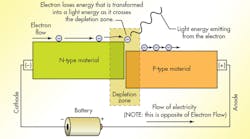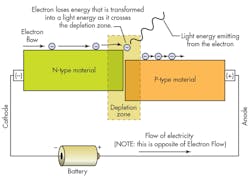Einstein said: “Energy cannot be created or destroyed, it can only be changed from one form to another.” For many light bulbs, this typically means an electrical energy that’s sent through a material—the filament—which heats up. Some of this electrical energy changes into heat and some changes into light.
For light-emitting diodes (LEDs), the material is, of course, a diode rather than a filament. A diode, simply put, is a semiconductor that allows electrical current to flow in one direction. One way to make diodes is by doping the conducting material so that it has two regions. There is a p-type, positive region, and an n-type, negative region. An anode attaches to the p-type side and a cathode to the n-type side. When electrons cross over the border where the two regions meet (the p-n junction), some of the electron energy is “lost” or changed into light.
The 49 million LEDs installed in 2012 save an estimated $675 million in energy costs. In 2013, LEDs used in lighting applications throughout the U.S. eliminated more than 12 million tons of CO2 emissions.
LEDs En Masse
It took mass production of LEDs to make the above numbers possible. Following on that theme, several suitable methods have emerged for producing LEDs on a large scale.
One of the more common manufacturing methods has technicians making structured 3D semiconductors by first growing a crystal, then slicing and polishing it into a thin wafer, known as the substrate. Layers of crystals are grown on the substrate’s surface and shot with ions to fill gaps in the 3D matrix of the semiconductor. This creates the p- and n-regions.
It has proven more cost-effective from a fabrication standpoint, since thousands of LEDs are made on a single wafer. For example, a 2-in. diameter wafer can yield up to 6,000 LEDs. However, producing a single LED chip from a wafer requires a specialized cutting process, which inevitably reduces the overall yield. Thus, to lower the price of LEDs and semiconductors, a better method is needed to separate them.
The next step in the fabrication process involves coating diodes to form metal contacts, and then connecting two wires to the different sides. Finally, this assembly is placed in a mold, where it gets a protective housing. One of the most common housings is a plastic dome. Housings can also be designed to act as a lens to improve the final LED’s optical qualities.


